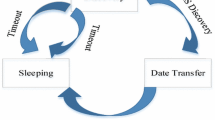Abstract
Data collection is one of the fundamental functions in wireless sensor networks (WSNs). Different from a typical WSN with only a single and stationary sink, this paper considers a scenario with multiple mobile sinks. The motivation is for a WSN to support future applications, such as Internet of Things (IoT). In this case, a WSN requires abilities to deliver sensing results to multiple users roaming in the network. There are two difficulties in this problem: sink mobility and multiple sinks. Since sinks are mobile, data delivery paths need to be updated frequently, which causes huge maintenance cost. To resolve this problem, we propose a hop-count-based architecture together with an efficient mobility management scheme. On the other side, sensing results from a large number of sensors are delivered to multiple sinks, which causes lots of packet transmissions. To reduce transmission cost, the concepts of multicast and data aggregation are integrated and applied. We first prove that a distributed multicast decision is a NP-hard problem and then propose a heuristic solution. Afterward, we further merge data aggregation into multicast and propose a distributed many-to-many aggregation scheme. Simulations are constructed to evaluate the efficiency of the proposed schemes. The results show that both the proposed multicast scheme and many-to-many aggregation scheme can efficiently reduce transmission cost and energy when delivering data to multiple mobile sinks.















Similar content being viewed by others
References
Yick J, Mukherjee B, Ghosal D (2008) Wireless sensor network survey. Comput Netw 52(12):2292–2330
Mainwaring A, Culler D, Polastre J, Szewczyk R, Anderson J (2002) Wireless sensor networks for habitat monitoring. In: Proceedings of ACM international workshop on wireless sensor networks and applications (WSNA), pp 88–97
Kroc S, Delic V (2003) Personal wireless sensor network for mobile health care monitoring. In: Proceedings of international conference on telecommunications in modern satellite, cable and broadcasting service (TELSIKS), pp 471–474
Li Z, Li M, Wang J, Cao Z (2011) Ubiquitous data collection for mobile users in wireless sensor networks. In: Proceedings of IEEE INFOCOM, pp 2246–2254
Pughat A, Sharma V (2015) A review on stochastic approach for dynamic power management in wireless sensor networks. Human-centric Comput Inf Sci 5(4). doi:10.1186/s13673-015-0021-6
Mottola L, Picco GP (2011) MUSTER: adaptive energy-aware multisink routing in wireless sensor networks. IEEE Trans Mob Comput 10(12):1694–1709
Weng H-C, Chen Y-H, Wu E, Chen G-H (2012) Correlated data gathering with double trees in wireless sensor networks. IEEE Sens J 12(5):1147–1156
Gnawali O, Fonseca R, Jamieson K, Moss D, Levis P (2009) Collection tree protocol. In: Proceedings of ACM conference on embedded networked sensor systems (SenSys), pp 1–14
Salam HA, Rizvi SR, Ainsworth S, Olariu S (2008) A durable sensor enabled lifeline support for firefighters. In: Proceedings of IEEE INFOCOM Workshops, pp 1–6
Atzor L, Iera A, Morabito G (2010) The internet of things: a survey. Comput Netw 54(15):2787–2805
Liu S-Y, Huang C-C, Huang J-L, Hu C-L (2012) Distributed and localized maximum-lifetime data aggregation forest construction in wireless sensor networks. In: Proceedings of IEEE International conference on pervasive computing and communications workshops (PERCOM Workshops), pp 655–660
Kweon K, Ghim H, Hong J, Yoon H (2009) Grid-based energy-efficient routing from multiple Sources to multiple mobile sinks in wireless sensor networks. In: Proceedings of international symposium on wireless pervasive computing (ISWPC)
Wang Y-H, Huang K-F, Huang Y-M, Tsao S-W (2011) An instantaneous data dissemination mechanism with mobile sinks in wireless sensor network. In: Proceedings of IEEE International conference on advanced information networking and applications (AINA), pp 385–390
Lee E, Park S, Yu F, Kim S-H (2010) Communication model and protocol based on multiple static sinks for supporting mobile users in wireless sensor networks. IEEE Trans Consum Electron 56(3):1652–1660
Dahane A, Berrached N, Loukil A (2015) A virtual laboratory to practice mobile wireless sensor networks: a case study on energy efficient and safe weighted clustering algorithm. J Inf Process Syst 11(2):205–228
Wu S, Candan KS (2006) GMP: Distributed geographic multicast routing in wireless sensor networks. In: Proceedings of IEEE international conference on distributed computing systems (ICDCS)
Sanchez JA, Ruiz PM, Liu J, Stojmenovic I (2007) Bandwidth-efficient geographic multicast routing protocol for wireless sensor networks. IEEE Sens J 7(5):627–636
Xiang X, Wang X, Yang Y (2010) Stateless multicasting in mobile ad hoc networks. IEEE Trans Comput 59(8):1076–1090
Silberstein A, Yang J (2007) Many-to-many aggregation for sensor networks. In: Proceedings of IEEE international conference on data engineering (ICDE), pp 986–995
Wu X, Chen G (2007) Dual-sink: using mobile and static sinks for lifetime improvement in wireless sensor networks. In: Proceedings of international conference on computer communications and networks (ICCCN), pp 1297–1302
Kusy B, Lee H, Wicke M, Milosavljevic N, Guibas L (2009) Predictive QoS routing to mobile sinks in wireless sensor networks. In: Proceedings of international conference on information processing in sensor networks (IPSN), pp 109–120
Croce S, Marcellon F, Vecchio M (2007) Reducing power consumption in wireless sensor networks using a novel approach to data aggregation. Comput J 51(2):227–239
Farahani S (2008) ZigBee wireless networks and transceivers. Newnes, Newton, MA
Gupta G, Misra M, Garg K (2015) An energy efficient distributed approach-based agent migration scheme for data aggregation in wireless sensor networks. J Inf Process Syst 11(1):148–164
Author information
Authors and Affiliations
Corresponding author
Additional information
C.-F. Huang’s research is sponsored by NSC under Grant No.103-2221-E-194 -023 -MY2.
Rights and permissions
About this article
Cite this article
Huang, CF., Lin, WC. Data collection for multiple mobile users in wireless sensor networks. J Supercomput 72, 2651–2669 (2016). https://doi.org/10.1007/s11227-015-1550-5
Published:
Issue Date:
DOI: https://doi.org/10.1007/s11227-015-1550-5




